The wreck of the Machault
Battle of the Restigouche National Historic Site
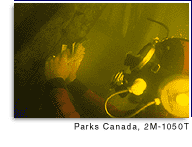 Divers doing underwater archaeological excavations
Divers doing underwater archaeological excavations© Parks Canada / Robert Grenier / 2M-1050-T
After resting for more than 200 years at the bottom of the Restigouche estuary, the wreck of the The Machault has finally revealed its secrets. Thanks to underwater archaeological excavations conducted from 1969 to 1972, a large collection of artifacts was uncovered, which have added to our knowledge of the battle and the type of trade occurring between France and the colony during this period.
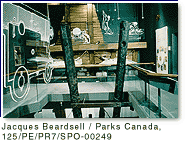 Interior view of the interpretation centre
Interior view of the interpretation centre© Parks Canada / Jacques Beardsell / 125/PE/PR7/SPO/00249
The archaeological site of the battle of the Restigouche provides an important window onto the material culture of 18th-century North America, as you will discover upon visiting the reconstituted interior of the ship.
The Council Room
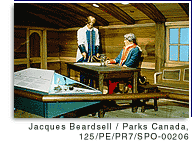 Reconstitution of the council room
Reconstitution of the council room© Parks Canada / Jacques Beardsell / 125/PE/PR7/SPO/00206
Aboard the ship, officers of the relief expedition discussed the objectives and risks of their mission. Five of the flotilla's six ships were poorly armed merchant ships. With 26 cannons manned by approximately 100 soldiers and 150 crew members, the frigate The Machault was the only ship capable of adequately defending the convoy.
 Character representing Lieutenant François Chenard de La Giraudais
Character representing Lieutenant François Chenard de La Giraudais© Parks Canada / Jacques Beardsell / 125/PE/PR7/SPO/00217
Lieutenant François Chenard de La Giraudais, the commander of the flotilla, had the qualifications and experience required to undertake this mission. In 1759, he was the first mate on board the same vessel when it escorted approximately twenty sailing ships to Québec.
 Character representing Captain François Gabriel d'Angeac
Character representing Captain François Gabriel d'Angeac© Parks Canada / Jacques Beardsell / 125/PE/PR7/SPO/00217
Captain François Gabriel d'Angeac, a knight of Saint-Louis, was commander of the marine infantry on board. On account of his previous record of service and his thorough knowledge of the colony, he was a natural choice for heading the land troops sent as reinforcements.
Life on Board Ship
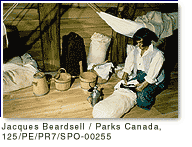 A sailor in the between-decks of the frigate
A sailor in the between-decks of the frigate© Parks Canada / Jacques Beardsell / 125/PE/PR7/SPO/00255
In addition to the goods and munitions stored in its hold, the The Machault carried 150 crew members and 100 soldiers who were crammed together in the between-decks. The dark and the damp conditions made life even more difficult in these exceedingly close quarters.
As voyages were often quite long, it was difficult to keep food and fresh water from spoiling. Feeding the occupants of the between-decks was a constant source of problems. Numerous dietary deficiencies were observed among passengers. Vessels were frequently infested with vermin as well.
Precious Cargo
 Munitions that were stored in the hold of the vessel
Munitions that were stored in the hold of the vessel© Parks Canada / Jacques Beardsell
In spring 1760, the holds of the six relief ships departing from Bordeaux were filled to bursting. This cargo represented the last hope of salvation for New France, where five years of war had exhausted all its resources.
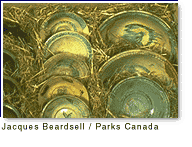 Dishware that was shipped as cargo
Dishware that was shipped as cargo© Parks Canada / Jacques Beardsell
- Date modified :